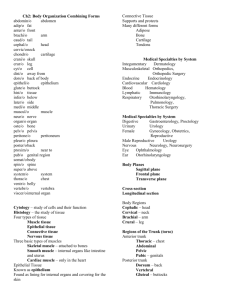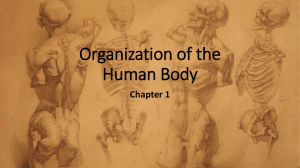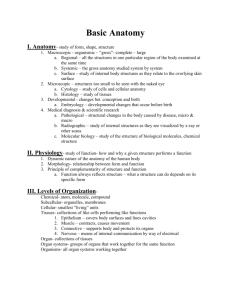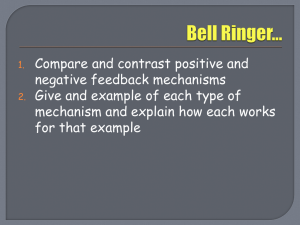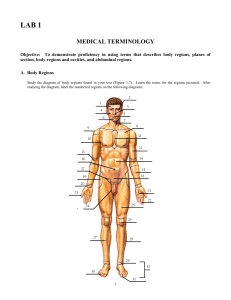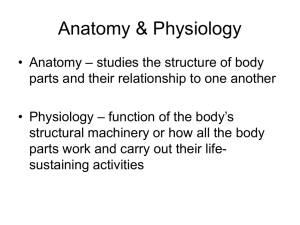erminology - El Camino College
advertisement
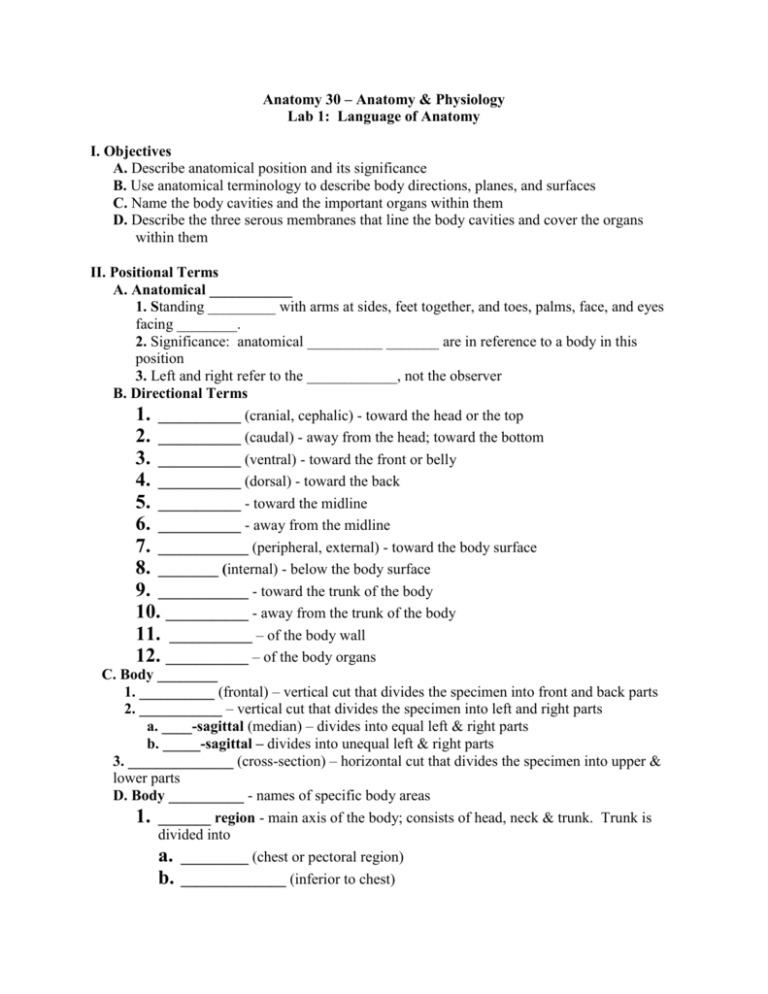
Anatomy 30 – Anatomy & Physiology Lab 1: Language of Anatomy I. Objectives A. Describe anatomical position and its significance B. Use anatomical terminology to describe body directions, planes, and surfaces C. Name the body cavities and the important organs within them D. Describe the three serous membranes that line the body cavities and cover the organs within them II. Positional Terms A. Anatomical ___________ 1. Standing _________ with arms at sides, feet together, and toes, palms, face, and eyes facing ________. 2. Significance: anatomical __________ _______ are in reference to a body in this position 3. Left and right refer to the ____________, not the observer B. Directional Terms 1. ___________ (cranial, cephalic) - toward the head or the top 2. ___________ (caudal) - away from the head; toward the bottom 3. ___________ (ventral) - toward the front or belly 4. ___________ (dorsal) - toward the back 5. ___________ - toward the midline 6. ___________ - away from the midline 7. ____________ (peripheral, external) - toward the body surface 8. ________ (internal) - below the body surface 9. ____________ - toward the trunk of the body 10. ___________ - away from the trunk of the body 11. ___________ – of the body wall 12. ___________ – of the body organs C. Body ________ 1. __________ (frontal) – vertical cut that divides the specimen into front and back parts 2. ___________ – vertical cut that divides the specimen into left and right parts a. ____-sagittal (median) – divides into equal left & right parts b. _____-sagittal – divides into unequal left & right parts 3. ______________ (cross-section) – horizontal cut that divides the specimen into upper & lower parts D. Body __________ - names of specific body areas 1. _______ region - main axis of the body; consists of head, neck & trunk. Trunk is divided into a. _________ (chest or pectoral region) b. ______________ (inferior to chest) 2 c. d. 2. __________ (hips) ______________ (region around anus & ext. genitals) _______________ region - limbs = appendages = extremities III. Surface Body Regions - areas that can be identified on the ______. Locate these on yourself and the torso model A. ______ (cephalus) - composed of two major areas 1. ________ region - includes the eyes, nose, and mouth 2. __________ (cranium) region - covers and supports the ______ B. Neck (_______ region) - supports the head and permits it to move C. ________ (torso) - part of the body to which the neck, upper and lower extremities attach; includes the thorax, abdomen, and pelvic regions 1. __________ (thoracic region) - chest; subregions include: a. Mammary - surrounds the nipples (_______) b. _________ - between the mammary regions c. _________ - armpit d. ___________ region - surrounds axilla e. Vertebral - extends the length of the back along the _______ column 2. _____________ - below the thorax; divided into __ regions to describe the location of internal organs a. R. _______________ - right, upper 1/3; gallbladder, liver, r. kidney b. ____________ - Upper, central 1/3; liver, stomach, pancreas, and duodenum c. L. _______________ - left, upper 1/3; spleen, colon, liver, l. kidney, small intestine d. R. _______ - right, lateral 1/3; cecum, ascending colon, liver, r. kidney, small intestine e. Umbilical - center; umbilicus (___) is located here; jejunum, ileum, duodenum, colon, kidneys, major abdominal vessels f. L. _________ - left, lateral 1/3; descending colon, l. kidney, small intestine g. R. _________ - right, lower 1/3; appendix, cecum, small intestine h. ____________ (pubic) - lower, center 1/3; urinary bladder, small intestine, sigmoid colon, female reproductive organs i. L. ___________ - left, lower 1/3; small intestine, descending colon, sigmoid colon D. __________ Region - lower portion of the trunk; includes 1. __________ area - covered by pubic hair in adults 2. __________ - contains the external sex organs and anal opening 3. __________ region - small of the back 4. __________ region - inferior to lumbar region, where vertebral column ends 3 5. Buttock (________) region - butt muscles E. Upper extremity - shoulders, arms & hands 1. __________ region - shoulder 2. __________ - arm 3. __________ region - between the arm and forearm; contains elbow; the cubital fossa is the depressed anterior portion of the cubital region (blood is often drawn here) 4. _______________ - forearm 5. ________ - hand; front is the _________ region (palm), back is the _________ of the hand. The manus has 3 main regions: a. Carpus - contains the ________ bones (in wrist) b. Metacarpus - contains the ____________ bones (in palm) c. Digits - consists of the ___________ bones (fingers) F. Lower extremity - hip, thigh, legs knees, & pes (feet) 1. ____________ region - thigh or upper leg 2. The ______ has two surfaces: a. _____________ region - knee cap b. _____________ region - back of knee 3. ______________ regions of the lower leg include: a. Anterior region includes the ______ b. Posterior region contains the ______ 4. The pes (foot) includes an ankle, heel, ________ surface (sole), and _________ (top surface), and has 3 major divisions: a. Tarsus contains the _______ bones (in ankle) b. Metatarsus contains the _____________ bones (in foot) c. Digits contain the _____________ bones (in toes) IV. __________ of the Body - locate on yourself and the torso model A. _________ body cavity - subdivided into two sections: 1. __________ cavity - lies within the skull & encases the brain, includes a. _____ cavity (2) – located in the skull below the nasal bones, bounded by the ethmoid bone and divided by the nasal septum b. ______ (buccal) cavity – internal mouth bounded by the palate, pharynx, cheeks, and tongue c. ________ (2) – eye sockets in the skull 2. _____________ cavity - runs through the vertebral column to enclose the spinal cord B. __________ body cavity - contains the visceral organs (______); has two main divisions, the thoracic & abdominopelvic cavities: 1. ___________ cavity - surrounded by ribs & chest wall muscles; subdivided into 3 parts: 4 a. b. 2. two lateral pleural cavities containing the _______ the pericardial cavity – contains the _______; found within the mediastinum region between the lungs _________________ cavity - enclosed by the abdominal wall & pelvic girdle; may be divided into two parts: a. ____________ cavity - contains the liver, stomach, kidneys, intestines, & other organs; surrounds the peritoneal cavity b. ___________ cavity - contains the urinary bladder, some reproductive organs, & the rectum c. The ___________ muscle separates the thoracic & abdominopelvic cavities V. ________ Membranes – epithelial tissue that lines body cavity walls and covers the organs within; secretes lubricating ________ fluid to minimize friction between the organs and body walls A. _________ – associated with the lungs in the thoracic cavity 1. ________ pleura – lines the thoracic cavity around the lungs 2. _________ pleura - covers the lung surfaces B. ________________ – associated with the heart 1. ____________ pericardium – loosely surrounds the heart 2. ____________ pericardium – adheres to the heart surface C. ______________ – associated with the peritoneal cavity of the abdominopelvic cavity 1. ___________ peritoneum – lines the abdominopelvic cavity 2. ___________ peritoneum – covers the organs within the cavity 3. ________________ – refers to those organs behind the parietal peritoneum, such as the kidneys, adrenal glands, most of the pancreas, the abdominal aorta and inferior vena cava



